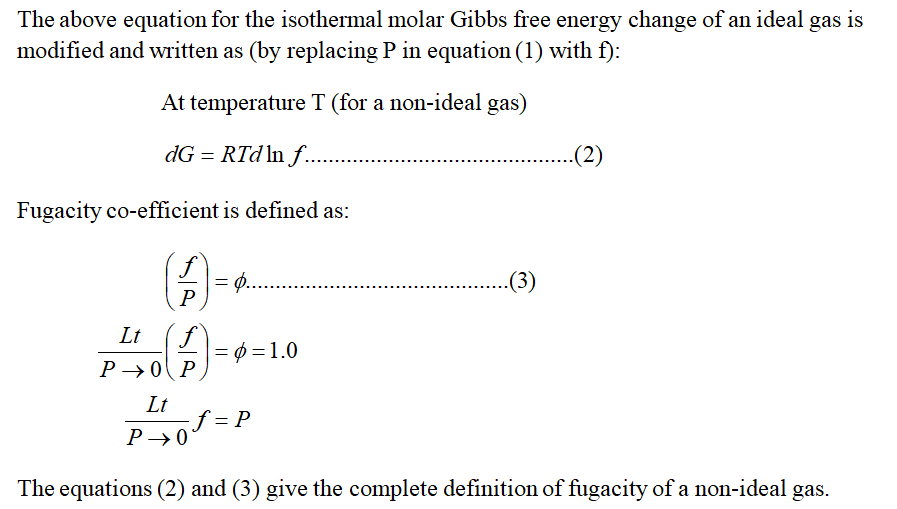Fugacity coefficient is a correction for non-ideal gas behavior. We know that as T increases, ideal gas behavic is more valid. Explain why in Fig.3-3, the fugacity coefficients are close to 1 (almost ideal gas) at low temperature but deviates from 1.0 at high temperature.
Fugacity coefficient is a correction for non-ideal gas behavior. We know that as T increases, ideal gas behavic is more valid. Explain why in Fig.3-3, the fugacity coefficients are close to 1 (almost ideal gas) at low temperature but deviates from 1.0 at high temperature.
Introduction to Chemical Engineering Thermodynamics
8th Edition
ISBN:9781259696527
Author:J.M. Smith Termodinamica en ingenieria quimica, Hendrick C Van Ness, Michael Abbott, Mark Swihart
Publisher:J.M. Smith Termodinamica en ingenieria quimica, Hendrick C Van Ness, Michael Abbott, Mark Swihart
Chapter1: Introduction
Section: Chapter Questions
Problem 1.1P
Related questions
Question
100%

Transcribed Image Text:4. Fugacity coefficient is a correction for non-ideal gas
behavior. We know that as T increases, ideal gas behavior
is more valid. Explain why in Fig.3-3, the fugacity
coefficients are close to 1 (almost ideal gas) at low
temperature but deviates from 1.0 at high temperature.

Transcribed Image Text:1.0
1.0
0.9-
10.9
ΜΕTHANΕ
0.8
0.8
0.7
1.아
40.6
0.9-
NITROGEN
0.8
0.8
0.7
1.아-
0.6
0.9-
PROPANE
0.8.
0.8
0.7
1.0
H0.6
0.9-
WATER
0.8-
0.8
0.7
0.7
0.6
0.5
0.6
1.0
0.6
0.7
0.8
0.9
REDUCED TEMPERATURE
Figure 3-3 Fugacity coefficients from vapor-phase volumetric data for four.
saturated liquids.
FUGACITY
COEFFICIENT
Expert Solution
Fugacity and fugacity co-efficient



Trending now
This is a popular solution!
Step by step
Solved in 3 steps with 7 images

Knowledge Booster
Learn more about
Need a deep-dive on the concept behind this application? Look no further. Learn more about this topic, chemical-engineering and related others by exploring similar questions and additional content below.Recommended textbooks for you

Introduction to Chemical Engineering Thermodynami…
Chemical Engineering
ISBN:
9781259696527
Author:
J.M. Smith Termodinamica en ingenieria quimica, Hendrick C Van Ness, Michael Abbott, Mark Swihart
Publisher:
McGraw-Hill Education

Elementary Principles of Chemical Processes, Bind…
Chemical Engineering
ISBN:
9781118431221
Author:
Richard M. Felder, Ronald W. Rousseau, Lisa G. Bullard
Publisher:
WILEY

Elements of Chemical Reaction Engineering (5th Ed…
Chemical Engineering
ISBN:
9780133887518
Author:
H. Scott Fogler
Publisher:
Prentice Hall

Introduction to Chemical Engineering Thermodynami…
Chemical Engineering
ISBN:
9781259696527
Author:
J.M. Smith Termodinamica en ingenieria quimica, Hendrick C Van Ness, Michael Abbott, Mark Swihart
Publisher:
McGraw-Hill Education

Elementary Principles of Chemical Processes, Bind…
Chemical Engineering
ISBN:
9781118431221
Author:
Richard M. Felder, Ronald W. Rousseau, Lisa G. Bullard
Publisher:
WILEY

Elements of Chemical Reaction Engineering (5th Ed…
Chemical Engineering
ISBN:
9780133887518
Author:
H. Scott Fogler
Publisher:
Prentice Hall


Industrial Plastics: Theory and Applications
Chemical Engineering
ISBN:
9781285061238
Author:
Lokensgard, Erik
Publisher:
Delmar Cengage Learning

Unit Operations of Chemical Engineering
Chemical Engineering
ISBN:
9780072848236
Author:
Warren McCabe, Julian C. Smith, Peter Harriott
Publisher:
McGraw-Hill Companies, The